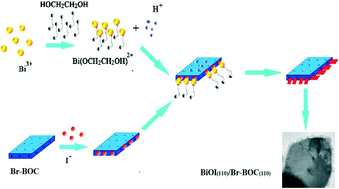Facet-selective interface design of a BiOI(110)/Br-Bi2O2CO3(110) p–n heterojunction photocatalyst†
Abstract
The facet-selective interface design for photocatalytic materials has been proven to be a versatile approach to enhance their photocatalytic performance. In this article, BiOI(110)/Br-Bi2O2CO3(110) p–n heterostructures were designed and synthesized by facet-dependent selective adsorption. Ultra-thin BiOI nanosheets uniformly grow on the (110) facet of a Br-Bi2O2CO3 nanoplate by crystallographically oriented epitaxial growth, which results in the high interface quality. The (110) facet that forms the interface is also the electron-active surface of Br-Bi2O2CO3, which improves the migration rate of the photoelectrons across the interface to the surface reactive sites. The photocatalytic activity of the as-made products is evaluated by the degradation of methyl orange (MO) under visible light irradiation. The results show that the BiOI(110)/Br-Bi2O2CO3(110) p–n heterostructure displays higher photocatalytic activity than pure phase Br-Bi2O2CO3 and BiOI, and 100% of the MO can be degraded in 30 min under visible light irradiation. This enhanced photocatalytic performance is attributed to the synergistic effect of the high interface quality, high migration rate of the separated electrons to the surface active sites and suitable band alignment of the BiOI and Br-Bi2O2CO3. This work offers an effective route to design the junction structures with a facet-selective interface.



 Please wait while we load your content...
Please wait while we load your content...